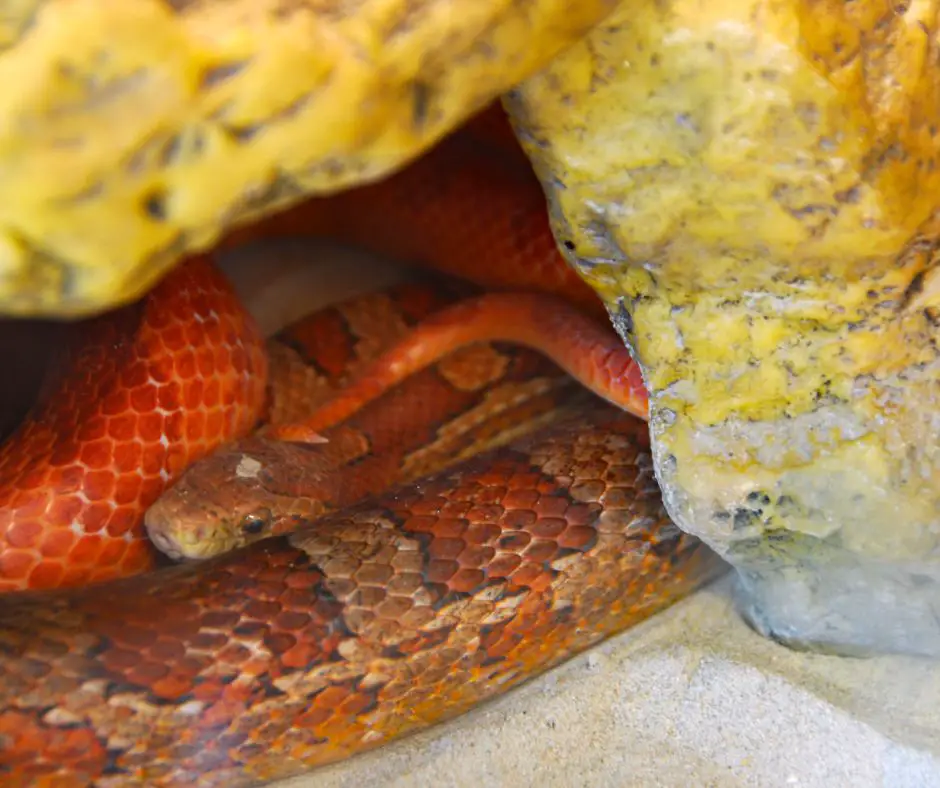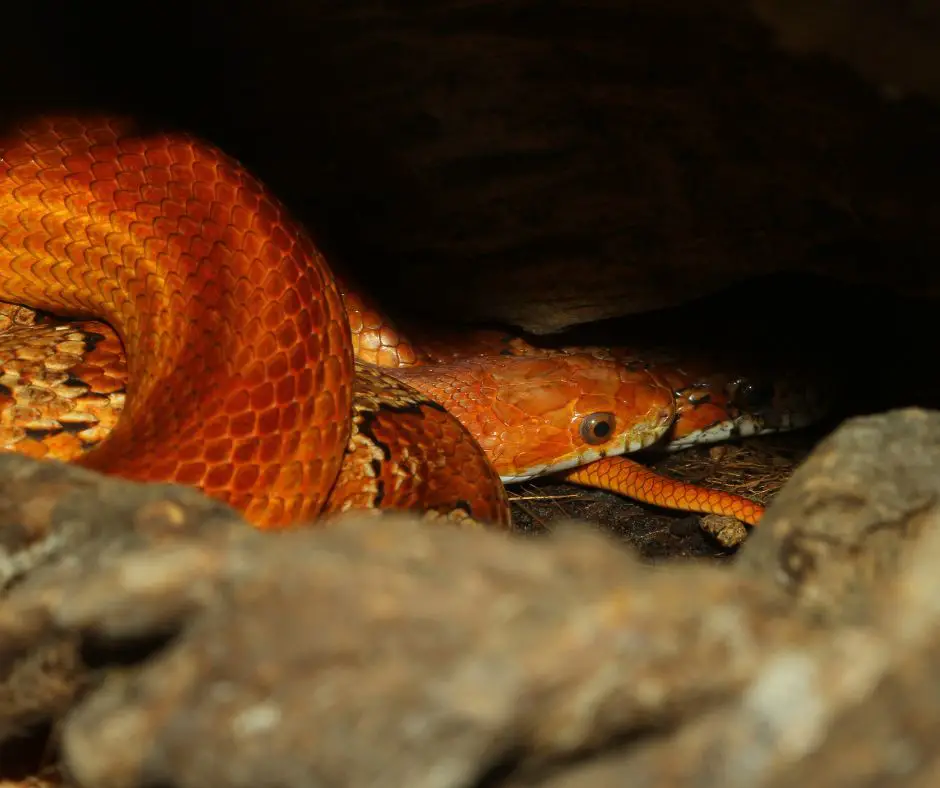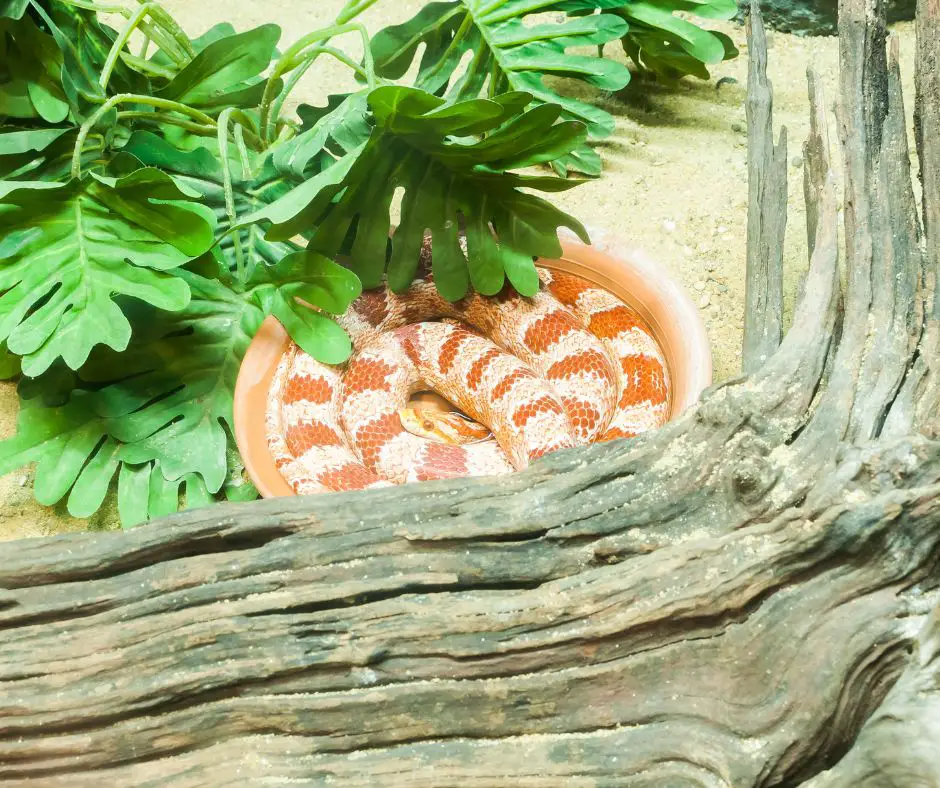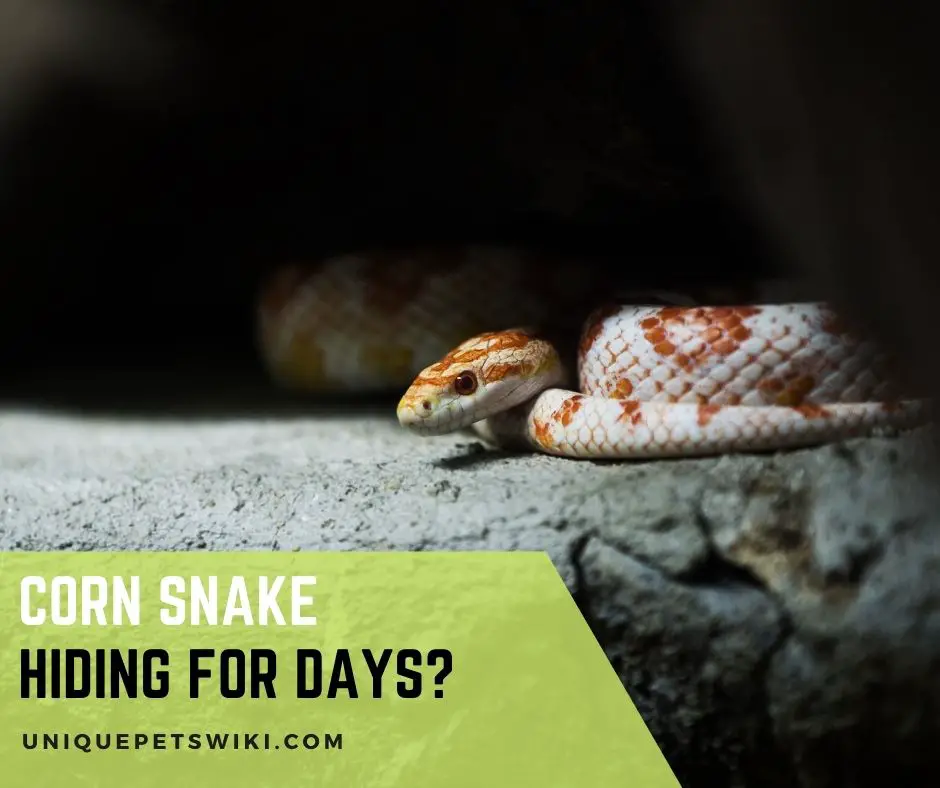Corn snakes, also called red rat snakes, are one of the popular snake species that you can keep as a pet. They are crepuscular creatures as they are active in the morning and evening. They love hiding a lot, and you can be concerned as an owner if your snake is hiding for a long time.
Generally, corn snakes hide during the day, whether in captivity or the wild. Apart from their natural instincts, corn snakes can also hide for several reasons, such as brumation, thermoregulation, stress, poor handling, and much more.
In this article, we will break down everything you need to know about corn snakes hiding for days, from the causes to how you can help your snake come out of hiding.
Contents
Why Is Corn Snake Hiding for Days and Not Moving Out?

Your corn snake behavior is normal if it comes out of hiding to roam around at night or once you turn off the light. Sometimes, you may think that your snake is hiding all the time, but it comes out when you are not watching. Therefore, you don’t really have to worry about your snake hiding if it eats.
Your corn can even hide for about 1-2 weeks when shedding. Some of the reasons for a corn snake to go hiding are stress, brumation, suffering from poor handling, thermoregulating, or adjusting to a new enclosure.
Thermoregulate
Snakes are cold-blooded creatures which means they need to thermoregulate. In the wild, they will bask under the sun when they need warm temperatures and move to cooler areas to cool off. This is why it is advisable to put hides in both the warm and cool zones of their cage for your snake to thermoregulate in peace.
Therefore, your snake may be thermoregulating if it stays hiding for a long time under a certain area. Once you notice this, you can check the temperature in the warm and cool areas to understand why your snake is hiding.
It may be due to an area not having the right temperature, and your snake compensates for it by hiding all the time.

Going Into Brumation
In the wild, snakes can become less active and go into brumation during the fall and winter. Corn snakes do not brumate in captivity because the temperature and light in their enclosure are controlled artificially. However, they will go into a pseudo-brumation state if the temperature in their enclosure is too low.
During the brumation period, your corn snake may hide a lot as they are not as active as before. They will also refuse food in this state but will drink water from time to time. Your corn snake will only come out of brumation when the temperature in its enclosure is back to an ideal level.
Stressed in Open Spaces
Another common reason your corn snake goes into hiding for a long time is when stressed in open spaces.
It is common for a corn snake to become stressed when introduced to a new environment. Therefore, the snake’s instinct is to stay hidden until it becomes familiar with its surroundings. This does not mean something is wrong with the enclosure set-up; you can give your snake time to adjust.
Another reason your corn snake stays hidden for days is if the enclosure is too large or there is not enough cover and hides in the enclosure. This way, your snake will feel insecure in the space as they feel exposed. Therefore, they try to hide to stay safe.

Your snake can also stay hidden when the day-lit hours are more. This is natural as corn snakes are usually more active at night than during the day.
Some of the ways to prevent stress in open space for your snake are:
- Ensure the temperature in their enclosure is correct.
- Ensure there is enough cover, whether fake or real plants and hides on both ends of your snake’s enclosure.
- You can also get your snake used to a new environment by luring it out with food.
Nervous Around Something
Your snake can go into hiding if it is nervous about something present around them. This may be because a predator like your pet cat is watching it all the time. It can also be that the location of your place or their enclosure is too noisy, affecting them.
Another thing is that your snake may be scared by a stranger, or it is shy and does not come out of hiding when you are watching it.
The best way to solve this problem is to detect the stress factor and remove it. For instance, you may need to house your snake in a quiet location far from the noise in the house, and your pets, like cats, do not have access to the room.
Another thing is that you should reduce how long you stay around your snake to give it enough privacy and get used to coming out.
Avoid Being Handled
It is possible for a baby or new corn snake not used to handling to spend more time hiding than snakes that love the handling. You can determine that your snake is not used to handling if it goes into hiding immediately after you return it to the enclosure after handling.
This is a common issue for young snakes or snakes getting rehomed.
Another reason your corn snakes go hiding is if your snake has suffered from poor handling. Poor handling can occur if you are over eager to handle your snake, which can stress out your snake, and your snake will not bond with you.
For instance, a corn snake can suffer from poor handling if you handle it after it eats or is still digesting its food. Another thing is if you force your snake to move in a direction. This can then make your snake determine that it is not safe with you and will try to hide out of your reach whenever you are around.
Therefore, it is important that you handle your snake properly so it can grow to be secure around you.
Stuck In Hides
Although this is rare, your corn snake can get stuck in their hides. This can happen when your snake is eager to get out of a hole and believes it can accommodate half of its body at once. Therefore, the body get stuck as it try to squeeze its body to get out.
They can also get stuck if they try to fit their body in tight spaces which cannot accommodate them. However, snakes usually have an awareness of their body limits. Getting stuck is usually due to the random size of the hide instead of the snake.
How Do You Get Corn Snakes to Come out of Hiding?
The first thing that you need to do if you want to lure your snake out of hiding is to determine why it is hiding. This is because you cannot do much but wait if your snake is sleeping, sick, shedding, or adjusting to its environment.
Some of the ways that you can get your corn snake to come out of hiding are stated below:
- Check the temperature in their enclosure to ensure it is not too hot in the hot area.
- Try to remove anything stressing your snake.
- Check if your snake is stuck in their hides.
- Ensure you handle your snake correctly to help build a bond with them.
- Entice your corn snake to come out by offering a tasty meal.
- Ensure there is enough cover, whether fake or real plants, hides on both ends of your snake’s enclosure.
Zilla Reptile Habitat Décor Hideouts Bark Bends, Medium
- Naturalistic appearance of natural wood bark blends in with terrestrial or aquatic environments
- Satisfies the need for burrowing animals to instinctively dig, find privacy and overhead coverage
- Set open ends alongside the glass or look through the window at the top to get a fascinating glimpse of activity
- Non-porous exterior resists bacterial growth
- Easy to clean with warm, soapy water and rinse
Last update on 2023-01-02 / Affiliate links / Images from Amazon Product Advertising API
FAQs
How long will a corn snake hide?
Generally, how long your corn snake hides will determine the snakes. It is likely for your snake to be in its hide when sleeping. Therefore, the activity level of your snake will be based on its personality as some corn snakes will prefer to stay hiding while some will love to explore when not sleeping.
However, your corn snake will hide for about 1-2 weeks when shedding.
Where would a corn snake hide?
In the wild, corn snakes like to hide under logs or rocks and can also hide under logs or rocks if available in captivity. However, the most common place for corn snakes to hide in captivity is the hide box, bedding, or the decorations available in their enclosure.
Why is my snake not active?
Generally, snakes are not that much of an active pet. However, if your snake looks less active than it used to be, then it may be due to the several reasons listed below:
– Your snake is nearing its shed.
– Your snake is going into brumation.
– The temperature in its enclosure is not ideal.
– Your snake is sick or gravid.
– The enclosure where you keep your snake is too big.
– It just ate and needed time to digest the food.
Conclusion
Generally, corn snakes spend their day hidden while they get more active at night. Therefore, hiding does not indicate that your snake has a problem, as if there is no issue with it or its setup.
We hope this article helps to answer all your questions about why your corn snake has been hiding for days. You can send us a message in the comment section below if you have any question or comment on why your snake is hiding.

